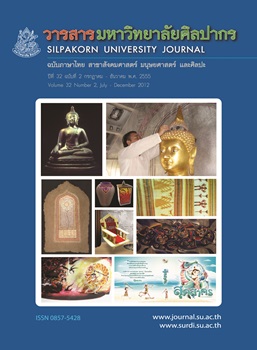นิกายพุทธศาสนาในล้านนา ระหว่างรัชสมัยพระเจ้าติโลกราชถึงพญาแก้ว (พ.ศ. 1984-2068) : ศึกษาจากพระพุทธรูปสัมฤทธิ์ที่มีจารึกในจังหวัดเชียงใหม่ Buddhist Sects in Lān Nā between the Reigns of Phayā Tilōk to Phayā Kaeo (1441-1525) : Studies from Dated Bronze Buddha Images in Chiang Mai
Main Article Content
Abstract
บทคัดย่อ
สังคมและวัฒนธรรมของคนในดินแดนเอเชียอาคเนย์มีความเข้มแข็งมาแต่ครั้งบรรพกาลเพราะสามารถเลือกรับปรับเปลี่ยนวัฒนธรรมจากภายนอกให้เหมาะสมกับสภาพสังคม ประเพณี และความเชื่อของตนเองอยู่ตลอดเวลา ตรงกับทฤษฎี Syncretism (การประสานความแตกต่างทางปรัชญาหรือศาสนา) ซึ่งสะท้อนถึงการประนีประนอมเพื่อตอบสนองต่อความต้องการของคนในสังคมทั้งในด้านจิตใจและการดำรงชีวิต หรือแม้แต่ด้านการเมืองการปกครอง กรณีของพุทธศาสนาในล้านนายุครุ่งเรืองระหว่างรัชสมัยพระเจ้าติโลกราชถึงพญาแก้ว (พ.ศ.1984-2068) ก็เช่นกัน เพราะแม้ว่าจะเป็นที่เข้าใจกันมาตลอดว่ามีที่มาจากคตินิกายเถรวาทหนพื้นเมือง และนิกายลังกาวงศ์หนสวนดอกและหนป่าแดง แต่แท้จริงแล้วพุทธศาสนานิกายเถรวาทแบบลังกาวงศ์บนดินแดนล้านนากลับมีลักษณะที่ผสมผสานเอาคติความเชื่อในลัทธิมหายานและนิกายวัชรยานเข้ามาแนบแน่นจนเป็นอันหนึ่งอันเดียวกันไปแล้ว เห็นได้จากพุทธลักษณะของพระพุทธรูปตลอดจนประเพณีและพิธีกรรมที่เกี่ยวข้อง
งานวิจัยชิ้นนี้ได้พยายามใช้วิธีการศึกษาแบบสหสาขาวิทยาระหว่างศาสตร์ต่างๆ ทั้งทางประวัติศาสตร์พุทธศาสนา และการเปรียบเทียบพุทธลักษณะตลอดจนเทคนิคการสร้างพระพุทธรูประหว่างล้านนา ลังกา และเนปาล-ทิเบต การศึกษากระบวนการปั้นหล่อพระพุทธรูปในปัจจุบันระหว่างช่างทั้ง 3 กลุ่ม การศึกษามหาบุรุษลักษณะในคัมภีร์มหายานและเถรวาท และการศึกษาคติปรัชญาศาสนาตลอดจนประเพณีและพิธีกรรมที่เกี่ยวข้องอันได้แก่พิธีพุทธาภิเษกและคติการบรรจุพระธาตุในองค์พระพุทธรูป
จากการศึกษาพบว่าพระพุทธรูปเชียงใหม่ในช่วงยุครุ่งเรืองของล้านนาได้รับเอาประติมานวิทยาของพระพุทธรูปแบบปาละทั้งจากแคว้นเบงกอล พิหาร และแคว้นโอริสสา รวมทั้งประติมานวิทยาของพระพุทธรูปแบบเนปาล-ทิเบตบางประการในคติลัทธิมหายานและนิกายวัชรยานเข้ามาเป็นของตนเอง ซึ่งนอกจากบทบาทของศิลปะปาละที่ปรากฏในพระพุทธรูปหมวดพระพุทธสิหิงค์ที่ทราบกันดีอยู่แล้ว เรายังพบบทบาทศิลปะทิเบตในพระพุทธรูปปางมารวิชัยขัดสมาธิราบแบบเชียงใหม่บางองค์ มหาบุรุษลักษณะหลายประการของพระพุทธรูปล้านนายุครุ่งเรืองก็ตรงกับพระพุทธรูปเนปาล-ทิเบต ขณะเดียวกันพระพุทธรูปสัมฤทธิ์บางองค์ในยุคนี้ก็แสดงให้เห็นร่องรอยประเพณีการบรรจุพระธาตุในอุษณีษะซึ่งสามารถถอดออกจากพระเศียรได้ ประเพณีการบรรจุหัวใจ
พระเจ้าในพระพุทธรูปล้านนาที่ยังคงปฏิบัติกันอยู่ในปัจจุบันก็สามารถเทียบเคียงได้กับประเพณีรับเนของทิเบตซึ่งต้องมีการบรรจุซุงหรือธารณีและซกชิงหรือต้นไม้แห่งชีวิตในพระพุทธรูป รวมถึงคติการเคารพบูชาพระพุทธรูปทั้งในฐานะอุเทสิกเจดีย์และธรรมเจดีย์ควบคู่กัน พระเจ้าติโลกราชกษัตริย์องค์สำคัญในยุคนี้ยังทรงใช้คติพุทธศาสนุปถัมภกและจักรวรรดิราชาในการแผ่ขยายอำนาจของพระองค์จนสร้างความเข้มแข็งแก่ราชวงศ์มังรายมาจนถึงรัชสมัยพญาแก้ว บันทึกการเดินทางของสงฆ์ทิเบตที่กล่าวถึงสังคมพุทธศาสนาในนครหริภุญไชย และหลักฐานการเดินทางไปนมัสการพระธาตุเจดีย์ที่พุกามของพระเถระเชียงใหม่ในช่วงพุทธศตวรรษที่ 21-22 ย่อมยืนยันถึงบทบาทของคติลัทธิมหายานและนิกายวัชรยานที่เข้ามาผสมผสานกับวัฒนธรรมล้านนา และเส้นทางที่พระสงฆ์ในลัทธินิกายนี้ใช้เดินทางเชื่อมต่อกับดินแดนต่างๆ ได้เป็นอย่างดี
คำสำคัญ: 1. พระพุทธรูป. 2. ยุครุ่งเรืองของล้านนา. 3. เถรวาท. 4. มหายาน. 5. วัชรยาน. 6. Syncretism.
Abstract
The social and cultural strength of the Southeast Asian region has prevailed since theancient times due to adaptation to the cultures from outside and based on the social condition,customs and beliefs. This corresponds to the syncretism theory (blending philosophical andreligious differences), which reflects the tendency for compromising to suit the needs, inboth social and spiritual terms, as well as the politics and government. The same is true inthe case of Buddhism in Lān Nā in its prosperous period during the reign of Phayā Tilōk tothat of Phayā Kaeo (A.D. 1441-1525) although it was thought to have derived from beliefsof the Theravāda Lankan Sect of Suan Dok and Pa Daeng as well as the Theravāda LocalSect from Haripunchai. In reality the Lankan Theravāda Buddhism in Lān Nā is a blend ofMahāyāna and Vajrayāna beliefs to such an extent that it became one. Evidence can be seenfrom the characteristics of some of the Buddha images and relevant customs. In fact, theLankan Buddhist art was partly derived from the Mahāyāna beliefs in the earlier times.
This research is considered to be multi-disciplinary as it involves Buddhist history, acomparison of Buddha image features, construction techniques for Buddha image making ofLān Nā, Sri Lankan, Nepal-Tibetan, a study of the casting process of Buddha images at thepresent time among three schools of artisans, a study on auspicious features of a great man inMahāyāna and Theravāda scriptures as well as beliefs about putting the Buddha relics insidesome Buddha images.
This research reveals that that there were some reasons to believe that during thetime when Buddhism was prosperous, Lān Nā had received the Pala style of Buddha imagefromBengal-Bihara, Orissa and Tibet based on Mahāyāna and Vajrayāna beliefs, which makesit difficult to identify the origins. In addition to the well-known characteristics of Phra PhutthaSihing, the role of Tibetan art was also detected in the Māravijaya Buddhist image of theChiang Mai style. Several characteristics of a great man found in La Na style Buddha imagesduring its prosperous era were also found in the Nepal-Tibet Buddha images. At the sametime, some bronze Buddha images of this period also reflect the custom of putting Buddha relics inside the images through usnīsa, the head part, which could be opened. Another similarpractice was placing the Buddha heart inside the Lān Nā Buddha images, which continuesuntil today, which could be related to the Tibetan custom of Rub Gnas where gzung or Srogshing was put inside the Buddha images. This includes the belief about paying respect to theBuddha images as Udesikachedi and Dharmachedi. Phayā Tilōk who was an important kingof that period used the Buddhist tradition of supporting Buddhism and Kingship in expandinghis power, resulting in the strength of the Mangrai Dynasty until the reign of Phayā Kaeo. Arecord of Tibetan monks’ journey about the Buddhist society in the City of Haripunchai andevidence of pilgrimages to pay respect to the chedi housing the Buddha relic at Pagan of somerevered monks from Chiang Mai during the 15th and 16th Centuries confirm the role and theroute of the Mahāyāna and Vajrayāna sects that blended into Lān Nā culture very well.
Keywords: 1. Buddha Image. 2. Golden Age of Lān Nā. 3. Theravāda. 4. Mahāyāna.5. Vajrayāna. 6. Syncretism.


